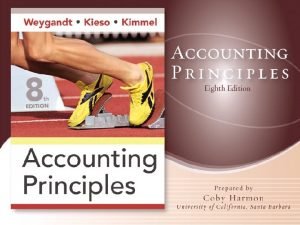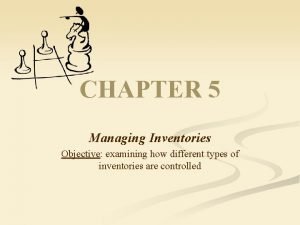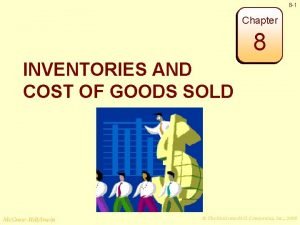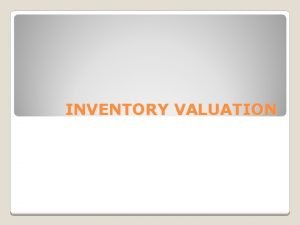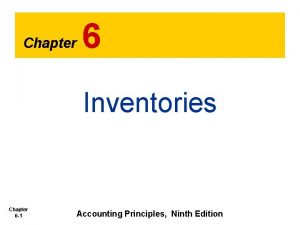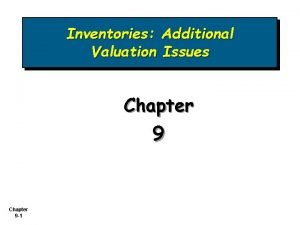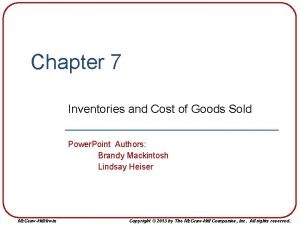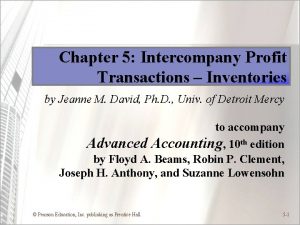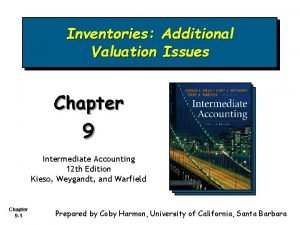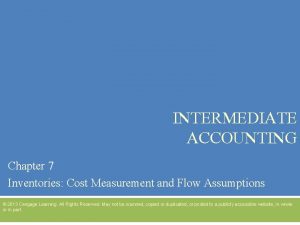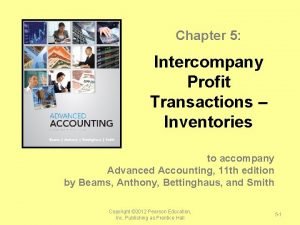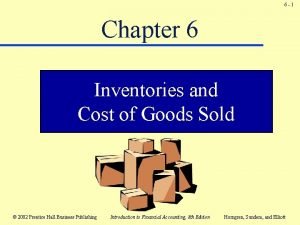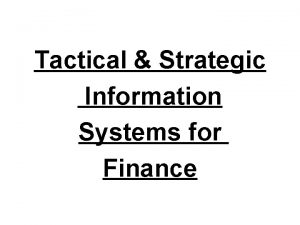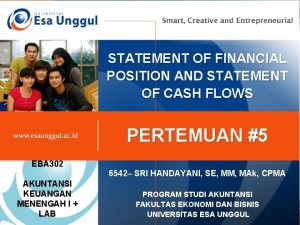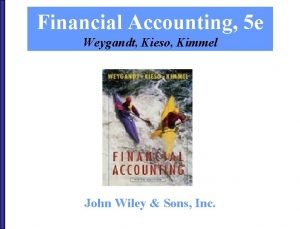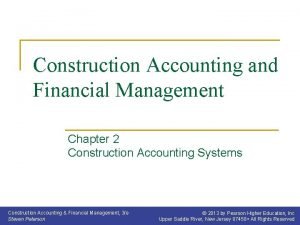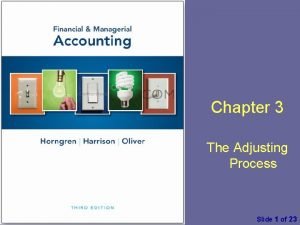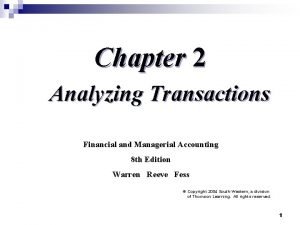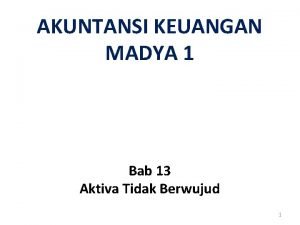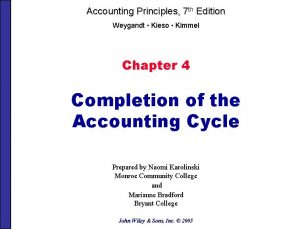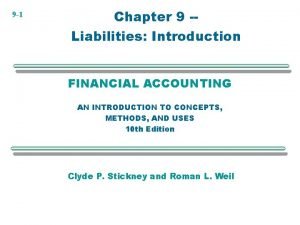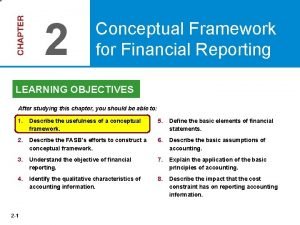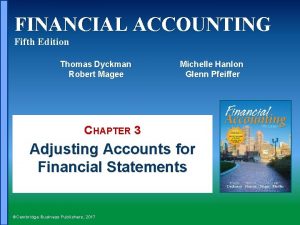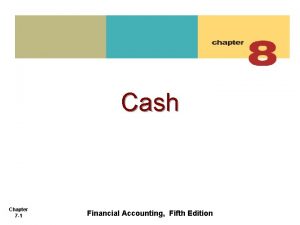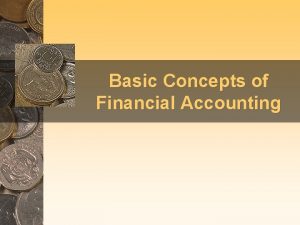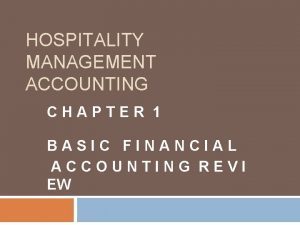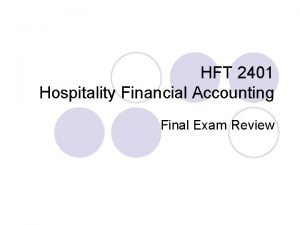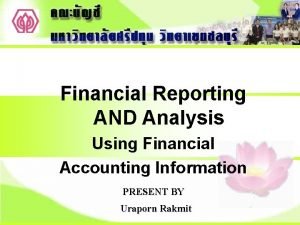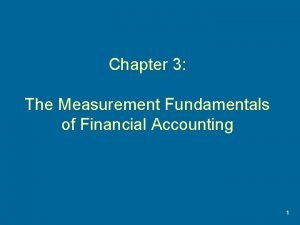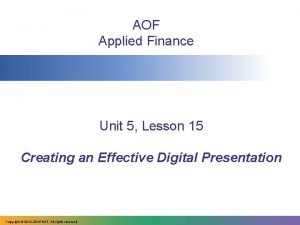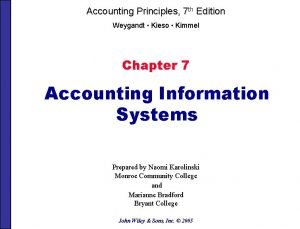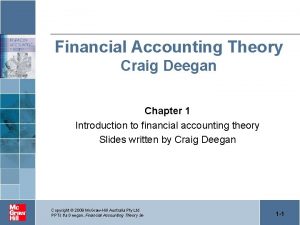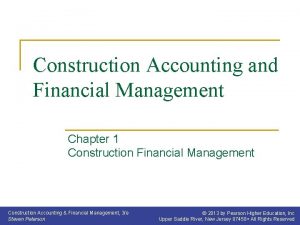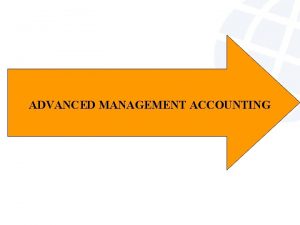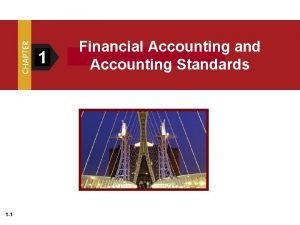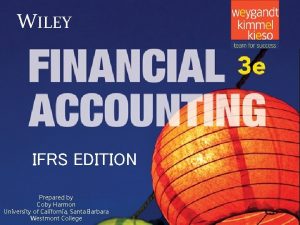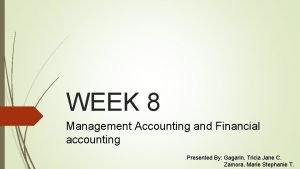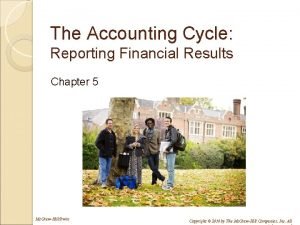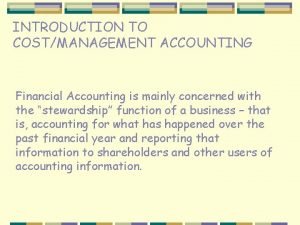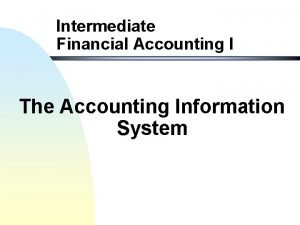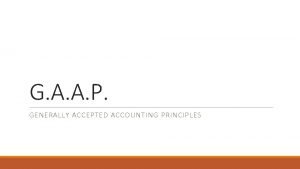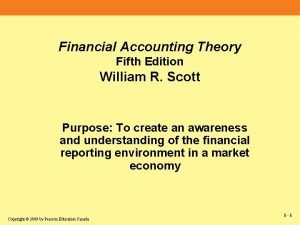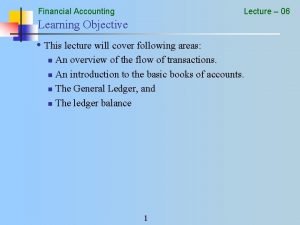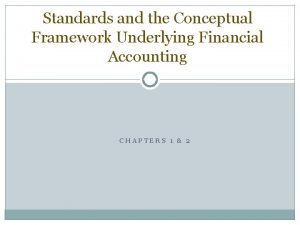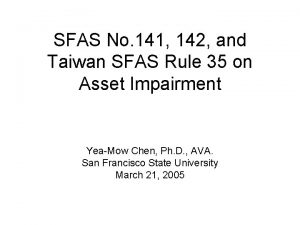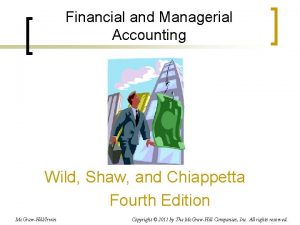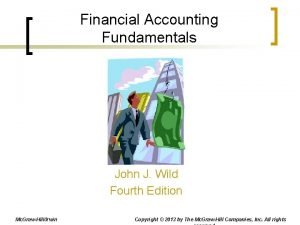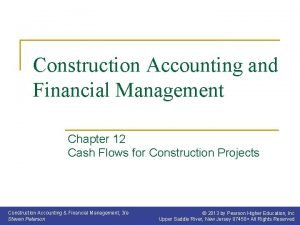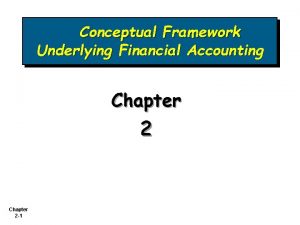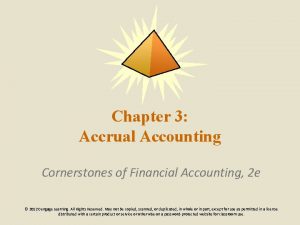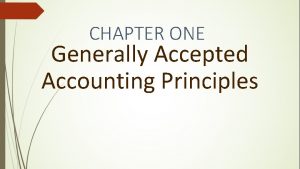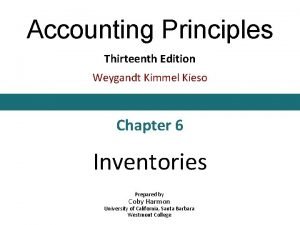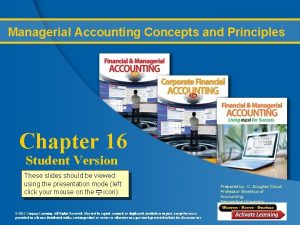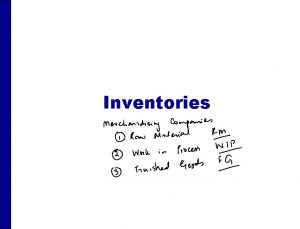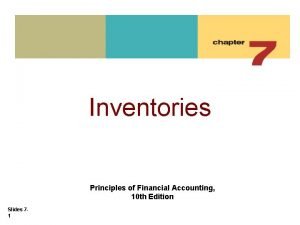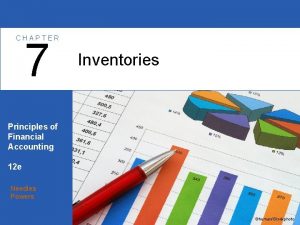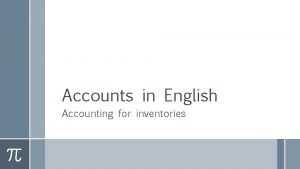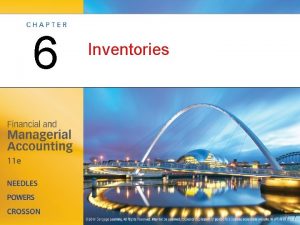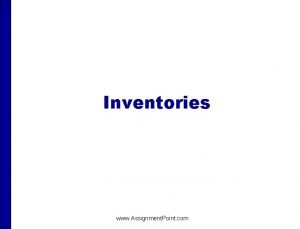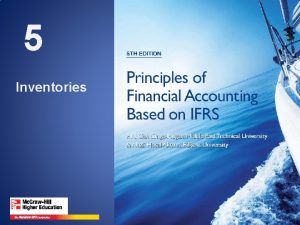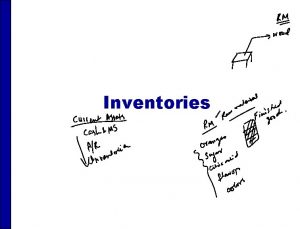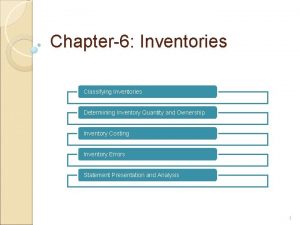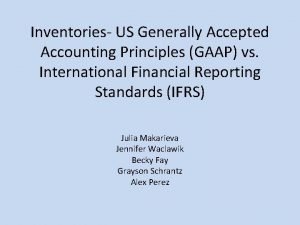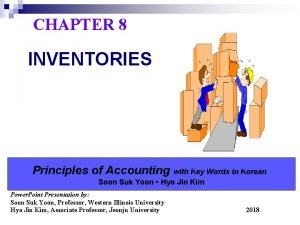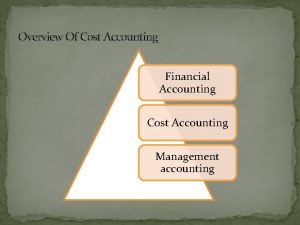7 Inventories Principles of Financial Accounting 11 e

































































































- Slides: 97

7 Inventories Principles of Financial Accounting, 11 e Reeve • Warren • Duchac 7 -

Inventories After studying this chapter, you should be able to: 7 -2 1 Describe the importance of control over inventories. 2 Describe three inventory cost flow assumptions and how they impact the income statement and balance sheet. 3 Determine the cost of inventory under the perpetual inventory system, using the FIFO, LIFO, and average cost methods.

Inventories (continued) Describe the cost of inventory under the 4 After studying this chapter, you should be able to: periodic inventory system, using the FIFO, LIFO, and average cost methods. 7 -3 5 Compare and contrast the use of the three inventory costing methods. 6 Describe and illustrate the reporting of merchandise inventory in the financial statements.

1 Describe the importance of control over inventory. 7 -4

1 Two primary objectives of control over inventory are: 1. Safeguarding the inventory, and 2. Properly reporting it in the financial statements. 7 -

1 • The purchase order authorizes the purchase of the inventory from an approved vendor. • The receiving report establishes an initial record of the receipt of the inventory. • The amount of inventory is always available in the subsidiary inventory ledger. 7 -

1 Controls for safeguarding inventory should include security measures to prevent damage and customer or employee theft. Some examples of security measures include the following: 1. Storing inventory in areas that are restricted to only authorized employees. 7 -

1 2. Locking high-priced inventory in cabinets. 3. Using two-way mirrors, cameras, security tags, and guards. 7 -

1 A physical inventory or count of inventory should be taken near year-end to make sure that the quantity of inventory reported in the financial statements is accurate. 7 -

2 Describe three inventory cost flow assumptions and how they impact the income statement and balance sheet. 7 -7 -10

2 7 - Inventory Costing Methods

2 May 10 Purchase 18 Purchase 24 Purchase Total 1 1 1 3 $ 9 13 14 $36 Average cost per unit $12 ($36 ÷ 3 units) 7 -

2 Assume that one unit is sold on May 30 for $20. Depending upon which unit was sold, the gross profit varies from $11 to $6 as shown below: 7 -

2 Under the specific identification inventory cost flow method, the unit sold is identified with a specific purchase. Not practical unless each inventory unit can be separately identified. 7 -

2 Under the first-in, first out (FIFO) inventory cost flow method, the first units purchased are assumed to be sold and the ending inventory is made up of the most recent purchases. 7 -

2 Under the last-in, first out (LIFO) inventory cost flow method, the last units purchased are assumed to be sold first and the ending inventory is made up of the first units purchased. 7 -

2 Under the average inventory cost flow method, the cost of the units sold and in ending inventory is an average of the purchase costs. 7 -

2 Exhibit 1 Effect of Inventory Costing Methods on Financial Statements FIFO Method Income Statement Sales $20 Cost of merchandise sold 9 Gross profit $11 7 - (continued)

2 Exhibit 1 Effect of Inventory Costing Methods on Financial Statements (continued) LIFO Method Income Statement Sales $20 Cost of merchandise sold 14 Gross profit $ 6 7 - (continued)

2 Exhibit 1 Effect of Inventory Costing Methods on Financial Statements (continued) Average Cost Method Income Statement Sales $20 Cost of merchandise sold 12 Gross profit $ 8 $36 ÷ 3 = $12 × 2 = $24 7 -

2 Exhibit 2 7 - Inventory Costing Methods* *Firms may be counted more than once for using multiple methods

2 Example Exercise 7 -1 Cost Flow Methods The three identical units of Item QBM are purchased during February, as shown below. Item QBM Units Cost Feb. 8 15 26 Purchase Total Average cost per unit 1 1 1 $ 45 48 51 3 $144 $48 ($144 ÷ 3 units) Assume that one unit is sold on February 27 for $70. Determine the gross profit for February and ending inventory on February 28 using (a) first-in, first-out (FIFO); (b) last-in, first-out (LIFO); and (c) average cost methods. 7 -22 7 -

2 Example Exercise 7 -1 (continued) Follow My Example 7 -1 Gross Profit Ending Inventory (a) First-in, first-out (FIFO): $25 ($70 – $45) $99 ($48 + $51) (b) Last-in, first-out (LIFO): $19 ($70 – $51) $93 ($45 + $48) (c) Average cost: $96 ($48 × 2) $22 ($70 – $48) For Practice: PE 7 -1 A, PE 7 -1 B 7 -23 7 -

3 Determine the cost of inventory under the perpetual inventory system, using the FIFO, LIFO, and average cost methods. 7 -24 7 -

3 First-In, First-Out Method On January 1, the firm had 100 units of Item 127 B that cost $20 per unit. Item 127 B Units Cost 100 7 - Jan. $20 1 Inventory

3 First-In, First-Out Method On January 4, the firm sold 70 units of 127 B at $30 each. Item 127 B Units 7 - Cost Jan. 1 100 4 $20 Sale 70 Inventory

3 Exhibit 3 7 - Entries and Perpetual Inventory Account (FIFO)

3 First-In, First-Out Method On January 10, the firm purchased 80 units at $21 each. Item 127 B Units Cost 100 4 10 7 - Jan. $20 Sale Purchase 1 Inventory 70 80 21

3 Exhibit 3 Entries and Perpetual Inventory Account (FIFO) (continued) 10 Merchandise Inventory Accounts Payable Date Jan. 1 7 - 1, 680

3 First-In, First-Out Method On January 22, the firm sold 40 units for $30 each. Item 127 B Units Cost 100 4 10 22 7 - Jan. $20 Sale Purchase Sale 1 Inventory 70 80 40 21

3 Exhibit 3 Date Jan. 1 7 - Entries and Perpetual Inventory Account (FIFO) (continued)

3 First-In, First-Out Method On January 28, the firm sold 20 units at $30 each. Item 127 B Units Cost 100 4 10 22 28 7 - Jan. $20 Sale Purchase Sale 1 70 80 40 20 Inventory 21

3 Exhibit 3 Date Jan. 1 7 - Entries and Perpetual Inventory Account (FIFO) (continued)

3 First-In, First-Out Method On January 30, purchased one hundred additional units of Item 127 B at $22 each. Item 127 B Units Cost 100 4 10 22 28 30 7 - Jan. $20 Sale Purchase 1 70 80 40 20 100 Inventory 21 22

3 Exhibit 3 7 - Entries and Perpetual Inventory Account (FIFO) (continued)

3 Exhibit 3 Entries and Perpetual Inventory Account (FIFO) (concluded) Cost of merchandise sold 7 - January 31 inventory

3 Example Exercise 7 -2 Perpetual Inventory Using FIFO Beginning inventory, purchases, and sales for Item ER 27 are as follows: Nov. 1 Inventory 40 units at $5 5 Sale 32 units 11 Purchase 60 units at $7 21 Sale 45 units Assuming a perpetual inventory system and the first-in, first-out (FIFO) method, determine (a) the cost of the merchandise sold for the November 21 sale and (b) the inventory on November 30. 7 -37 7 -

3 Example Exercise 7 -2 (continued) Follow My Example 7 -2 a) Cost of merchandise sold (November 21): 8 units @ $5 $40 37 units @ $7 259 45 units $299 b) Inventory, November 30: $161 = (23 units × $7) For Practice: PE 7 -2 A, PE 7 -2 B 7 -38 7 -

3 Last-In, First-Out Method On January 1, the firm had 100 units of Item 127 B that cost $20 per unit. Item 127 B Units Cost 100 7 - Jan. $20 1 Inventory

3 Last-In, First-Out Method On January 4, the firm sold 70 units of 127 B at $30 each. Item 127 B Units 7 - Cost Jan. 1 100 4 $20 Sale 70 Inventory

3 Exhibit 4 7 - Entries and Perpetual Inventory Account (LIFO)

3 Last-In, First-Out Method On January 10, the firm purchased 80 units at $21 each. Item 127 B Units Cost 100 4 10 7 - Jan. $20 Sale Purchase 1 Inventory 70 80 21

3 Exhibit 4 Entries and Perpetual Inventory Account (LIFO) (continued) 10 Merchandise Inventory Accounts Payable Date Jan. 1 4 7 - 1, 680

3 Last-In, First-Out Method On January 22, the firm sold 40 units for $30 each. Item 127 B Units Cost 100 4 10 22 7 - Jan. $20 Sale Purchase Sale 1 Inventory 70 80 40 21

3 Exhibit 4 Date Jan. 1 4 7 - Entries and Perpetual Inventory Account (LIFO) (continued)

3 Last-In, First-Out Method On January 28, the firm sold 20 units at $30 each. Item 127 B Units Cost 100 4 10 22 28 7 - Jan. $20 Sale Purchase Sale 1 70 80 40 20 Inventory 21

3 Exhibit 4 Date Jan. 1 4 7 - Entries and Perpetual Inventory Account (LIFO) (continued)

3 Last-In, First-Out Method On January 30, the firm purchased one hundred additional units of Item 127 B at $22 each. Item 127 B Units Cost 100 4 10 22 28 30 7 - Jan. $20 Sale Purchase 1 70 80 40 20 100 Inventory 21 22

3 Exhibit 4 Date Jan. 1 4 10 7 - Entries and Perpetual Inventory Account (LIFO) (continued)

3 Exhibit 4 Entries and Perpetual Inventory Account (LIFO) (concluded) Cost of Merchandise Sold 7 - January 31 Inventory

3 Example Exercise 7 -3 Perpetual Inventory Using LIFO Beginning inventory, purchases, and sales for Item ER 27 are as follows: Nov. 1 5 11 21 Inventory Sale Purchase Sale 40 units at $5 32 units 60 units at $7 45 units Assuming a perpetual inventory system and the last-in, first-out (LIFO) method, determine (a) the cost of the merchandise sold for the November 21 sale and (b) the inventory on November 30. 7 -51 7 -

3 Example Exercise 7 -3 (continued) Follow My Example 7 -3 a) Cost of merchandise sold: $315 = (45 units × $7) b) Inventory, November 30: c) d) e) 8 units @ $5 15 units @ $7 23 $ 40 105 $145 For Practice: PE 7 -3 A, PE 7 -3 B 7 -52

3 Moving Average When the average cost is used in a perpetual system, an average unit cost for each item is computed each time a purchase is made. The unit cost is then used to determine the cost of each sale until another purchase is made and a new average is computed. This averaging technique is called a moving average. 7 -

4 Determine the cost of inventory under the periodic inventory system, using the FIFO, LIFO, and average cost methods. 7 -54 7 -

4 First-In, First-Out Method Using FIFO, the earliest batch purchased is considered the first batch of merchandise sold. The physical flow does not have to match the accounting method chosen. 7 -

4 FIFO Method Jan. 1 100 units @ $20 = $2, 000 Jan. 10 80 units @ $21 = 1, 680 Jan. 30 100 units @ $22 = 2, 200 280 units available for sale during year $5, 880 Cost of merchandise available for sale 7 -

4 The physical count on January 31 shows that 150 units are on hand (conclusion: 130 units were sold). What is the cost of the ending inventory? Jan. 1 100 Sold unitsthese @ $20 Sold 30 of the 80 $ 0 Jan. 10 80 units @ $21 50 units @ $21 = 1, 050 Jan. 30 100 units @ $22 = 2, 200 Ending inventory 7 - = $3, 250

4 Now we can calculate the cost of goods sold as follows: Beginning inventory, January 1 (Slide 55) Purchases ($1, 680 + $2, 200) Cost of merchandise available for sale Ending inventory, January 31(Slide 56) Cost of merchandise sold 7 - $2, 000 3, 880 $5, 880 3, 250 $2, 630

4 Exhibit 5 7 - First-In, First-Out Flow of Costs

4 Last-In, First-Out Method Using LIFO, the most recent batch purchased is considered the first batch of merchandise sold. The actual flow of goods does not have to be LIFO. For example, a store selling fresh fish would want to sell the oldest fish first (which is FIFO) even though LIFO is used for accounting purposes. 7 -

4 LIFO Method Jan. 1 100 units @ $20 = $2, 000 Jan. 10 80 units @ $21 = 1, 680 Jan. 30 100 units @ $22 = 2, 200 280 units available for sale during year $5, 880 Cost of merchandise available for sale 7 -

4 Assume again that the physical count on January 31 is 150 units (and that 130 units were sold). What is the cost of the ending inventory? Jan. 1 100 units @ $20 = $2, 000 Jan. 10 50 units @ $21 80 units @ $21 == 1, 1, 050 680 100 Sold unitsthese @ $22 == 2, 2000 Sold 30 of the 80 Jan. 30 Ending inventory 7 - $3, 050

4 Now we can calculate the cost of goods sold as follows: Beginning inventory, January 1 (Slide 60) Purchases ($1, 680 + $2, 200) Cost of merchandise available for sale Ending inventory, January 31(Slide 61) Cost of merchandise sold 7 - $2, 000 3, 880 $5, 880 3, 050 $2, 830

4 Exhibit 5 7 - Last-In, First-Out Flow of Costs

4 Average Cost Method The average cost method is sometimes called the weighted average method. It uses the average unit cost for determining cost of merchandise sold and the ending merchandise inventory. 7 -

4 The weighted average unit cost is determined as follows: Total Cost of Units Available for Sale Average Unit Cost = Units Available for Sale 7 -

4 Jan. 1 100 units @ $20 = $2, 000 Jan. 10 80 units @ $21 = 1, 680 Jan. 30 100 units @ $22 = 2, 200 280 $5, 880 Average unit cost: $5, 880 ÷ 280 = $21 Cost of merchandise sold: 130 units at $21 = $2, 730 Ending merchandise inventory: 150 units at $21= $3, 150 7 -

4 Now we can calculate the cost of goods sold as follows: Beginning inventory, January 1 (Slide 66) $2, 000 Purchases ($1, 680 + $2, 200) 3, 880 Cost of merchandise available for sale $5, 880 Ending inventory, January 31(Slide 66) 3, 150 Cost of merchandise sold $2, 730 7 -

4 Example Exercise 7 -4 Periodic Inventory Using FIFO, LIFO, Average Cost Methods The units of an item available for sale during the year were as follows: Jan. 1 Inventory Mar. 20 Purchase Oct. 30 Purchase Available for sale 6 units @ $50 14 units @ $55 20 units @ $62 40 units $ 300 770 1, 240 $2, 310 There are 16 units of the item in the physical inventory at December 31. The periodic inventory system is used. Determine the inventory cost by (a) the first-in, first-out (FIFO) method, (b) the last-in, first-out (LIFO) method, and (c) the average cost method. 7 -69 7 -

4 Example Exercise 7 -4 (continued) Follow My Example 7 -4 a) First-in, first-out (FIFO) method: $992 (16 units × $62) b) Last-in, first-out (LIFO) method: $850 (6 units × $50) + (10 units × $55) c) Average method: $924 (16 units × $57. 75) where average cost = $57. 75 ($2, 310 ÷ 40 units) For Practice: PE 7 -4 A, PE 7 -4 B 7 -70 7 -

5 Compare and contrast the use of the three inventory costing methods. 7 -71 7 -

5 Partial Income Statements First-In, First-Out Net sales $3, 900 Cost of merchandise sold: Beginning inventory $2, 000 Purchases 3, 880 Merchandise available for sale $5, 880 Less ending inventory 3, 250 Cost of merchandise sold 2, 630 Gross profit $1, 270 7 -

5 Partial Income Statements Average Cost Net sales $3, 900 Cost of merchandise sold: Beginning inventory $2, 000 Purchases 3, 880 Merchandise available for sale $5, 880 Less ending inventory 3, 150 Cost of merchandise sold 2, 730 Gross profit $1, 170 7 -

5 Partial Income Statements Last-In, First-Out Net sales $3, 900 Cost of merchandise sold: Beginning inventory $2, 000 Purchases 3, 880 Merchandise available for sale $5, 880 Less ending inventory 3, 050 Cost of merchandise sold 2, 830 Gross profit $1, 070 7 -

5 Exhibit 7 7 - Effects of Changing Costs (Prices): FIFO and LIFO Cost Methods

5 Recap Weighted FIFO Average LIFO Ending inventory $3, 250 $3, 150 $3, 050 Cost of merchandise sold $2, 630 $2, 730 $2, 830 Gross profit $1, 270 $1, 170 $1, 070 7 -

6 Describe and illustrate the reporting of merchandise inventory in the financial statements. 7 -77 7 -

6 Cost is the primary basis for valuing and reporting inventories in the financial statements. However, inventory may be valued at other than cost in the following cases: (continued) 7 -

6 1. The cost of replacing items in inventory is below the recorded cost. 2. The inventory cannot be sold at normal prices due to imperfections, style changes, or other causes. 7 -

6 Market, as used in lower of cost or market, is the cost to replace the merchandise on the inventory date. 7 -

6 Cost and replacement cost can be determined for the following: 1. Each item in the inventory. 2. Each major class or category of inventory. 3. Total inventory as a whole. 7 -

6 Exhibit 8 7 - Determining Inventory at Lower of Cost or Market

6 Example Exercise 7 -5 Lower-of-Cost-or-Market Method On the basis of the following data, determine the value of the inventory at the lower of cost or market. Apply lower of cost or market to each inventory item as shown in Exhibit 8. Inventory Commodity Quantity C 17 Y B 563 7 -83 7 - 10 7 Unit Cost Price $ 39 110 Unit Market Price $40 98

6 Example Exercise 7 -5 (continued) Follow My Example 7 -5 For Practice: PE 7 -5 A, PE 7 -5 B 7 -84 7 -

6 Net Realizable Value Merchandise that is out of date, spoiled, or damaged should be written down to its net realizable value. This is the estimated selling price less any direct cost of disposal, such as sales commissions. 7 -

6 Merchandise Inventory on the Balance Sheet Merchandise inventory is usually presented in the Current Assets section of the balance sheet, following receivables. 7 -

6 Merchandise Inventory on the Balance Sheet The method of determining the cost of inventory (FIFO, LIFO, or weighted average) and the method of valuing the inventory (cost or the lower of cost or market) should be shown. 7 -

6 7 -

6 Effect of Inventory Errors on the Financial Statements Some reasons causing inventory errors to occur include the following: 1. Physical inventory on hand was miscounted. 2. Costs were incorrectly assigned to inventory. 3. Inventory in transit was incorrectly included or excluded from inventory. 4. Consigned inventory was incorrectly included or excluded from inventory. 7 -

6 Exhibit 9 7 - Effect of Inventory Errors on Current Period’s Income Statement

6 77 -91 Exhibit 10 Effect of Inventory Errors on Two Years’ Income Statements

6 Exhibit 11 7 - Effect of Inventory Errors on Current Period’s Balance Sheet

6 Example Exercise 7 -6 Effect of Inventory Errors Zula Repair Shop incorrectly counted its December 31, 2010 inventory as $250, 000 instead of the correct amount of $220, 000. Indicate the effect of the misstatement on Zula’s December 31, 2010 balance sheet and income statement for the year ended December 31, 2010. 7 -93 7 -

6 Example Exercise 7 -6 (continued) Follow My Example 7 -6 Amount of Misstatement Overstatement (Understatement) Balance Sheet: Merchandise inventory overstated Current assets overstated Total assets overstated Owner’s equity overstated Income Statement: Cost of merchandise sold understated Gross profit overstated Net income overstated $30, 000 $(30, 000) 30, 000 For Practice: PE 7 -6 A, PE 7 -6 B 7 -94 7 -

Appendix: Estimating Inventory Cost 7 -95 7 -

Exhibit 12 7 - Determining Inventory by the Retail Method

Exhibit 13 7 - Estimating Inventory by the Gross Profit Method
 Intermediate accounting chapter 1
Intermediate accounting chapter 1 Ppt on responsibility accounting
Ppt on responsibility accounting Formal and informal assessment
Formal and informal assessment Accounting chapter 6
Accounting chapter 6 Non recycled inventories in housekeeping
Non recycled inventories in housekeeping Chapter 8 inventories and the cost of goods sold
Chapter 8 inventories and the cost of goods sold Wac inventory
Wac inventory Juloidian inventories
Juloidian inventories Sde classification
Sde classification Chapter 6 inventories
Chapter 6 inventories Chapter 9 inventories additional valuation issues
Chapter 9 inventories additional valuation issues Cost of good sold formula
Cost of good sold formula Upstream vs downstream intercompany sales
Upstream vs downstream intercompany sales Chapter 9 inventories additional valuation issues
Chapter 9 inventories additional valuation issues Inventory intermediate accounting
Inventory intermediate accounting Intercompany inventory transactions
Intercompany inventory transactions Smarter inventories
Smarter inventories Chapter 6 inventories
Chapter 6 inventories Examples of non financial methods of motivation
Examples of non financial methods of motivation What is tactical information system
What is tactical information system Statement of financial position
Statement of financial position Management accounting definition
Management accounting definition Nature of cost accounting
Nature of cost accounting Management accounting nature
Management accounting nature Kimmel accounting 5e
Kimmel accounting 5e Construction cost accounting basics
Construction cost accounting basics Income statement in financial accounting
Income statement in financial accounting Financial accounting chapter 2 solutions
Financial accounting chapter 2 solutions Unit 5 lesson 2 financial accounting
Unit 5 lesson 2 financial accounting Unit 5 lesson 2 financial accountings
Unit 5 lesson 2 financial accountings Financial accounting chapter 13
Financial accounting chapter 13 Equity accounted investments
Equity accounted investments Kimmel financial accounting 7the edition
Kimmel financial accounting 7the edition Financial accounting chapter 9
Financial accounting chapter 9 Conceptual framework for financial accounting
Conceptual framework for financial accounting Who is father of accounting
Who is father of accounting Financial accounting dyckman
Financial accounting dyckman Contra entry in control accounts
Contra entry in control accounts Financial accounting kimmel ch1-2
Financial accounting kimmel ch1-2 Financial accounting chapter 7
Financial accounting chapter 7 Basic concepts of accounting and finance
Basic concepts of accounting and finance Importance of financial accounting
Importance of financial accounting Unit 13 accounting and financial statements
Unit 13 accounting and financial statements Financial accounting ifrs 4th edition chapter 12
Financial accounting ifrs 4th edition chapter 12 Objective of financial accounting
Objective of financial accounting Cost of goods manufactured formula
Cost of goods manufactured formula Materiality concept in accounting example
Materiality concept in accounting example Hft 2401 exam 1
Hft 2401 exam 1 Using financial accounting information 10th edition
Using financial accounting information 10th edition Financial accounting mod 5
Financial accounting mod 5 Financial accounting chapter 3
Financial accounting chapter 3 Chapter 2 financial accounting answers
Chapter 2 financial accounting answers Appendix g financial accounting
Appendix g financial accounting Unit 5 lesson 2 financial accounting
Unit 5 lesson 2 financial accounting Kimmel financial accounting 7e
Kimmel financial accounting 7e Cost-benefit constraint
Cost-benefit constraint Financial management software for faith-based organizations
Financial management software for faith-based organizations Deegan financial accounting theory
Deegan financial accounting theory Introduction to construction financial management
Introduction to construction financial management Bafs accounting
Bafs accounting Ima accounting meaning
Ima accounting meaning Financial institutions accounting
Financial institutions accounting Accounting rules
Accounting rules Objectives of financial accounting
Objectives of financial accounting Internal users of accounting information
Internal users of accounting information Financial accounting chapter 5
Financial accounting chapter 5 Financial accounting is mainly concerned with
Financial accounting is mainly concerned with Closing entries example
Closing entries example Drawback of financial accounting
Drawback of financial accounting Accounting principles are generally based on
Accounting principles are generally based on Financial accounting theory scott
Financial accounting theory scott What is financial accounting
What is financial accounting Fasb conceptual framework
Fasb conceptual framework Sfas 141
Sfas 141 Wild financial and managerial accounting
Wild financial and managerial accounting Financial accounting wild
Financial accounting wild Construction accounting and financial management
Construction accounting and financial management Third level of conceptual framework
Third level of conceptual framework Introduction of computerized accounting
Introduction of computerized accounting Going concern concept
Going concern concept Biblical financial principles
Biblical financial principles Pharmacy accounting principles
Pharmacy accounting principles Accrual accounting principles
Accrual accounting principles Accounting principles second canadian edition
Accounting principles second canadian edition Accounting principles second canadian edition
Accounting principles second canadian edition Accounting principles second canadian edition
Accounting principles second canadian edition Accounting principles and concepts
Accounting principles and concepts Chapter 4 accrual accounting concepts
Chapter 4 accrual accounting concepts Accounting assumption
Accounting assumption Development phase of accounting
Development phase of accounting Generally accepted accounting principles (gaap) adalah
Generally accepted accounting principles (gaap) adalah Manual accounting information system
Manual accounting information system 6 principles of accounting
6 principles of accounting 13 basic governmental accounting principles
13 basic governmental accounting principles Beginning inventory formula
Beginning inventory formula Accounting principles second canadian edition
Accounting principles second canadian edition Constraint in accounting
Constraint in accounting Managerial accounting concepts and principles
Managerial accounting concepts and principles



